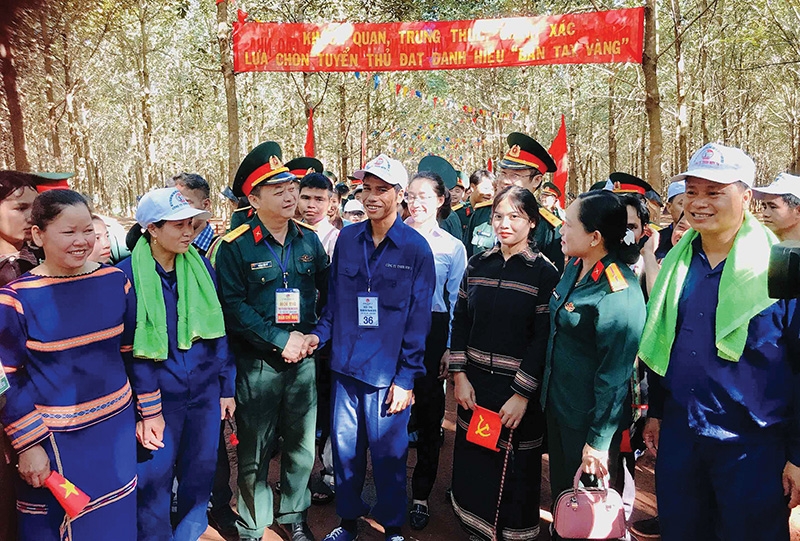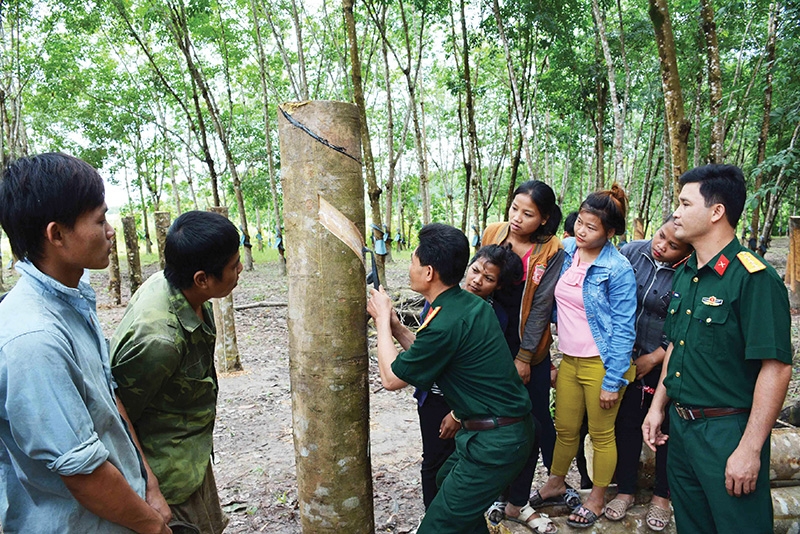Tapping into the potential of rubber
 |
| Villages are emerging from poverty thanks to teamwork, household integration, and skills competitions |
Born and raised in Dol village in Duc Co district, Ro Lan H’Blon only finished Grade 9 and was forced to quit school to find a job to support her family. She shared that it was a very difficult time when the whole family, including a frail mother and a mentally ill child, lived on a meagre income from farming and brocading.
Luck came in 2010 when H’Blon was accepted as a worker in the 9th Division of 74 Company. The company was part of 15 Corporation and was assigned to three rubber gardens. H’Blon said she was instructed by the company on how to care and shave latex from the trees, but it took more than 10 days to learn how to do it.
At first, H’Blon was worried that she could not complete the task because this was a job she had never experienced, while scraping rubber required meticulousness. Each time rubber latex was harvested, she would have to carry a container of latex weighing several tens of kilogrammes in the slippery forest, a concerning job especially whenever it rained.
But overcoming the challenges, this job gives her family a more prosperous and complete life. “In the first year, the average salary was only up to VND4 million ($175) per month, but then increased to closer to VND8 million ($350). My husband and I also planted 500 coffee trees, 200 cashew trees, three fields of wet rice, and the income each year is more than VND100 million ($4,350)”, said H’Blon.
Although the price of rubber latex recently fell sharply and the monthly income from tapping returned to the original level of VND4 million, H’Blon confirmed that she will continue this work and at the same time, has mobilised more women from the same village to register to participate for the company’s guidance and support.
“I love this job. When I saw the tapping workers, I liked it so I asked my father to participate,” she explained. “He disagreed, but I was still determined to become a rubber tapper. It was the only way to help me out of poverty and the present results proved that I was right.”
 |
| Households are being encouraged to take advantage of what the rubber latex business could bring |
Joining the call
H’Blon is one of a few thousand people living in 185 communes across 17 districts and towns of Gia Lai, who have invited each other to quit their jobs of trapping wild animals and picking wild vegetables to exploit rubber latex instead.
The economic value that this industrial crop brings in, nearly 40 years since the first rubber trees were planted and replicated in the Central Highlands provinces by the soldiers of 15 Corporation, has changed the lives of many households. The main beneficiaries and the most significant changes in life happened in ethnic minorities.
Instead of having to move to other places to find work, people were able to stay in their homeland. Stable income from rubber latex helps them to have a new, and modern life, gradually eliminating backward practices.
According to Colonel Hoang Van Sy, commander of 15 Corporation, the recruitment of workers for the rubber forests is extremely favourable now, but to get results requires the hard work of many cadres and employees over the years.
“To convince people, nothing works more than understanding their culture and integrating into their lives. From getting acquainted, we will then persuade and guide them to change their lifestyle,” the colonel said. “From working with outdated farming practices in the past, they know how to develop their economy with suitable crops.”
Currently, 15 Corporation has created jobs for more than 10,000 workers, of which nearly half are ethnic minorities, through contracting planting, tending, exploiting, and processing the two main crops of rubber and coffee.
With the rapid changes in the positive direction that rubber trees bring, one person passes on to the other, the number of rubber workers increases every year. The couple Ro Lan Mlu is a typical example. Both husband and wife have been working as rubber tappers of 715 Company for five years. The total income of the couple each month reaches VND14-15 million ($600-$650), and their livelihood is stable compared to many local households.
“Rubber latex prices have fallen recently, but we determine that rubber trees are still the spearhead of the company. The reason is that this plant is drought tolerant, suitable for the weather conditions of the region and the farming practices of locals,” Sy explained.
Attracting workers
The attraction of rubber trees and products thereof also entices many people to come here to find jobs. From a poor and sparsely-populated mountainous region, Kon Tum and Gia Lai have now become an attractive new economic region.
Vi Thi Giang, from Chu Prong district in Gia Lai, shared that she left the central province of Thanh Hoa for Gia Lai in 2010 and has been a worker of the 10th team at Binh Duong Company ever since. The new job helps her and her husband live a decent life with their three children.
“My family’s life is getting better. We built a new house and have a stable income which is enough to take care of the family,” said Giang.
15 Corporation has successfully implemented a model that connects households. Kinh’s families and their ethnic minority counterparts are now helping each other develop economically, reduce poverty, share difficulties, and maintain security and order in the area. Some 4,000 pairs of households mounted in nine clusters across 225 villages in Gia Lai, Kon Tum, and the central province of Quang Binh have been successfully deployed in this way.
Siu Toi, who lives in Bia village in Ia Grai district shared, “Thanks to household cohesion, workers in my village and others have emerged from poverty.
The Kinh’s households have helped ethnic minority households to shave latex, and grow rice, coffee, and rubber for economic development. Without the model of household integration, perhaps there would not have been as many local people working here as there is now.”
In order to motivate and encourage employees to participate in production, 15 Corporation also regularly organises competitions to improve the skills of the rubber tappers. As a result, the productivity of the corporation’s rubber orchards is always at the top of the Central Highlands region, with an average of 1.6-1.8 tonnes of dry rubber latex per hectare annually, even some gardens reaching more than two tonnes per ha on a yearly basis.
According to Vu Thi Thu, deputy head of Gia Lai People’s Mobilisation Committee, the province currently has 17 focal units undertaking mobilisation work in 71 communes in 17 districts and cities.
In particular, the activities and economic models of 15 Corporation are considered the most typical model of the province, contributing to creating more jobs for local people and raising incomes.
Rubber trees, originating from crops introduced to Vietnam during French colonial rule in the late 19th and early 20th centuries, have become the main industrial crop contributing to economic improvement for households in Gia Lai and Kon Tum.
Contrary to labour exploitation and harsh conditions on rubber plantations during French colonial times, rubber workers now live a full life and the number of worker families with 2-3 generations of rubber trees is growing, with their latex products widely sold both at home and abroad.
What the stars mean:
★ Poor ★ ★ Promising ★★★ Good ★★★★ Very good ★★★★★ Exceptional
 Tag:
Tag:
Themes: Climate Change Response
Related Contents
Latest News
More News
- Protect what’s next: towards a future free from meningococcal group B disease (December 05, 2025 | 18:00)
- New ILO report offers policy recommendations for disability inclusion (December 04, 2025 | 15:18)
- Maternal job loss may affect children’s mental health, research shows (December 03, 2025 | 19:11)
- Women lead Vietnam’s shift to climate-resilient agriculture (December 03, 2025 | 19:10)
- Experts highlight unpaid care work as key barrier to gender equality (December 03, 2025 | 15:15)
- Opportunities and inequalities for women workers in Vietnam's garment industry (December 03, 2025 | 09:00)
- Vietjet flights carry love to devastated central region (November 28, 2025 | 11:35)
- New initiative to boost the fight against domestic violence (November 26, 2025 | 10:00)
- South Korea funds IOM relief for Vietnam’s typhoon-affected communities (November 24, 2025 | 15:33)
- AI and human-centred values set to shape the future of HR in Vietnam (November 21, 2025 | 18:04)
























 Mobile Version
Mobile Version